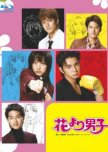Reviewing In Retrospect; ‘ Hana Yori Dango’
Four years after the Taiwanese hit series ‘ Meteor Garden’, Japanese network TBS finally commissioned the rights for adapting their own series based upon mangaka Yoko Kamio’s ‘ Hana Yori Dango’.
Despite the critically-mixed 1995 Japanese movie sharing the same title, TBS’ ‘ Hana Yori Dango’ marked the first domestic and televised production adaptation of Kamio’s manga onscreen .
After the unimaginable success across Asia of ‘ Meteor Garden’, ‘ Hana Yori Dango’ was undeniably left in its predecessor’s shadow. Nevertheless whilst perhaps ‘ Hana Yori Dango’ did struggle to attain the same international success as the Taiwanese adaptation, the Japanese series was well-received domestically as well as amongst small circles of international drama enthusiasts at the time.
The series marked the breakthrough roles and the array of talents from several young and familiar faces in the Japanese acting industry ( especially Inoue Mao, Matsumoto Jun and Oguri Shun), as well as gain successful popularity through a sequel season and a movie adaptation also. However despite the drama’s praiseworthy reception for being one of the most “ underrated” adaptations, ‘ Hana Yori Dango’ cannot escape from its flaws either.
Similar to its predecessor( ‘ Meteor Garden’) and its source material, TBS’ ‘ Hana Yori Dango’ reimburses the “ Modern Cinderella” tale with “ mundane” main female lead Tsukushi Makino ( Inoue Mao). Makino is an ordinary middle-class girl who attends the elitist and and private Eitoku Gakuen through an acclaimed scholarship. However despite the prestige for attending the school, Makino is regularly sickened by the materialistic beliefs and principles of her wealthy classmates. Determined, Makino pledges that she’ll keep her head down until graduation.
However despite her obstinate decision, Makino’s plans are soon scuppered when she ends up befriending Sanjo Sakurako ( Sato Megumi). Sakurako ends up on the wrong side of the notorious Tsukasa Domyouji ( Matsumoto Jun). The conglomerate heir of one of Japan’s richest families and the ring leader of the school’s notorious clique, the F4, Tsukasa is renowned for his merciless bullying tactics . In particular, Tsukasa is associated with sending his signature “ red card”; the recipient being instantly labelled as a social pariah by the rest of the school.
Unable to sit back and watch her new friend suffer, Makino declares war on the leader of the F4. Nevertheless despite Tsukasa’s red card and bullying schemes , Makino finds comfort and determination to carry on through her crush on mysterious and suave F4 member, Hanazawa Rui ( Oguri Shun).
Meanwhile Tsukasa’s growing contempt and fascination for the female lead soon provides to complicate matters further, as Domyouji Tsukasa finds himself falling in love with Makino Tsukishi. As Makino finds herself torn between her complicated feelings, Tsukasa’s estranged and fierce mother Domyouji Kaede ( Kaga Mariko) proves only to complicate matters further…
Adapted to the small screen by a small screen of different directors ( Katayama Osamu, Ishii Yasuharu and Yamamuro Daisuke) and screenwriters ( Takuma Takayuki, Fujimoto Yuki, Takahashi Natsuko and Arai Shuuko), ‘ Hana Yori Dango’ has often been cited by aficionados of the franchise as one of the most “ faithful” adaptations to date. ( Although the series does notably adapt and tweak certain events from the manga in order to expedite storyline.)
The series is notably lighthearted and niche in parts. The comical elements of the series rely heavily upon sociocultural and sociolinguistic jokes which whilst offering certain comical relief , can be harder to grasp for audience members unfamiliar with Japanese culture.( One of the most notable gags in the series found through the original manga joke surrounding Tsukasa’s malapropisms, the “lessons” taught by Makino’s father [ Kobayashi Susumu] to her younger brother Makino Susumu [ Tomiura Satoshi] , as well as Tsukishi’s boss and dumpling store owner Sengoku Sachiyo[ Kato Takako]’s “eventful” past with famous celebrities.)
Nevertheless despite some over-the-top jokes within ‘ Hana Yori Dango’, the narrative could surprisingly take a wistful edge at times also. Domyouji’s estranged relationship with his mother is brief yet subtly tumultuous for audiences, whilst the throbbing teen-angst surrounding Makino’s feelings and Hanazawa Rui’s unrequited love for his sister-figure Todo Shizuka ( Sada Mayumi), is given a bittersweet presence within the events of the narrative.
On the other hand it’s undeniable that ‘ Hana Yori Dango’ isn’t a storyline inescapable from predictable and shoehorned tropes. The events surrounding the female lead’s “ dilemmas” as well as the archetypes of “ niche bullies” or “ twists” often led to predictable outcomes. As a consequence, it was apparent that ‘ Hana Yori Dango’’s heavy reliance upon themes surrounding bullying, assault and blackmail were
quintessential for the events of the storyline, but were given a ham-fisted approach by the writers.
Despite Mao Inoue debuting as an actress around the age of five, ‘ Hana Yori Dango’ is still considered one of Inoue’s breakout roles playing main female lead Tsukishi Makino. The young actress’ performance is admittedly slightly exaggerated in parts with certain line deliverances and comical dialogue exchanges often falling flat at certain times . Nevertheless, Inoue Mao was able to carry on through her performances during some of the drama’s more sincere and heartfelt moments with a dynamic charm.
As a character, Tsukishi Makino is notably headstrong, resilient as well as kindhearted. Whilst it is important to respect that other incarnations of the character are variable and independent from one another, it is notable that Makino’s inability to bend so easily at first to the will of Domyouji Tsukasa gave her a slightly more tactful and resilient edge at times than other versions. On the other hand similar to numerous counterparts, Makino could often feel as though she was somewhat dulled by her greater character drives and goals outside of her “ potential” love interests.
Costarring alongside Mao was Matsumoto Jun. A member of the famous ARASHI boyband, Matsumoto Jun’s performance as Domyouji Tsukasa was admittedly heartfelt as well as somewhat dull in parts. Jun’s comical or lighthearted exchanges could sometimes lack finesse. On the other hand Jun’s prior acting experience in dramas such as ‘ Gokusen’ seemed to come to good use during heart-wrenching moments of the series, by adding an angst-ridden charm to his onscreen persona also.
Domyouji Tsukasa is an interpretative character for screenwriters and directors alike. However Tsukasa’s character archetype has notably fallen into two categories throughout past adaptations; fractious, jovial and angsty, or satirical, brooding and unpredictable. As it happens Jun’s Domyouji Tsukasa notably fell into the latter category for most of the series. ( Similar to his manga counterpart.)Tsukasa did notably have his “ darker” character moments, but the screenplay was heavily focused upon presenting a more lighthearted as well as a “ complicated” familial scenario for Tsukasa. However similar to his manga counterpart and other adaptations, Tsukasa’s greatest character flaw could often be found through his inability to truly repent or be remorseful over his actions or treatment of others; offering limited character development at times for the male lead.
Then of course there’s Oguri Shun as second male lead Hanazawa Rui. Similar to his costar Mao Inoue, Shun’s acting career began during his childhood. On the other hand prior to his role in ‘ Hana Yori Dango’, Shun notably took on the roles of “unusual” characters such as his parts in ‘ Great Teacher Onizuka’, ‘ Summer Snow’ and ‘ Gokusen’.
Whilst playing the role as suave and mysterious Hanazawa Rui was certainly not a stretch for Shun, it seemed an unusual casting choice and decision for the actor to take on a “romantic potential love interest” role which could’ve easily been one-dimensional. Although Shun’s performance is somewhat limited in parts by dialogue and interactions, the acting surprisingly gave the second male-lead a charismatic and beguiling charm for audiences.
Hanazawa Rui’s onscreen counterparts have always differed. Whilst certain adaptations have depicted Rui as sweet, easygoing and somewhat flatline second male lead, others have stayed more faithful to the original manga by depicting Rui’s mysterious, cool-headed and taciturn personality. Naturally the Japanese version of Hanazawa Rui does make some nuanced changes towards Rui as a character in comparison to his predecessor and manga counterpart. On the other hand whilst Rui had his own character drive and a battle of ambivalent feelings, the second male lead could feel somewhat shoehorned into the plot through various scenarios as the narrative professed.
The chemistry between our main leads is admittedly variable. Whilst there are heart-wrenching and lighthearted moments where the onscreen chemistry between Shun, Inoue and Matsumoto could feel natural and concise, there were other moments in the series where this could feel limited and slightly stunted by plot.
Aside from the main cast, there is also Mimasaka Akira ( Abe Tsuyoshi) and Nishikado Sojiro ( Matsuda Shota), fellow F4 members, who whilst gradually developing an unlikely friendship with Makino and necessary at times for major plot dilemmas , could often feel somewhat staid and shoehorned into scenarios. Similar to the flawed position of Sojiro and Akira, there is also Makino’s best friend Matsuoka Yuki ( Nishihara Aki) and Tsukasa’s older sister, Domyouji Tsubaki ( Matsushima Nanako); supportive and kindhearted characters , but rarely having sentient character-drive also.
Hana Yori Dango’s narrative notably follows the first major arc of the manga with a fair degree of accuracy . ( Although notably certain minor events and characters are left out or tweaked.) The storyline is notably fast-paced during initial events and is mainly pacy in parts. Nevertheless by the halfway mark, the narrative notably slows down in order to focus on a dragged-out plot dilemma as well as the gradual events leading up to the finale. Whilst this wasn’t entirely a bad writing decision per say and did allow opportunities in order to focus on sentimental elements of the storyline, it could often create a slightly grating experience in parts for viewers by the second-half.
Under the directing reigns of the trio,’ Hana Yori Dango’ is notably an eclectic array of slick editing and shots as well as somewhat amateurish and sloppy editing techniques. Of course whilst it is important to review this in retrospect, ‘ Hana Yori Dango’ could still feel dated at times with its filming even for a 2000s drama. Nevertheless it is notable that despite some dated technology for modern viewers, ‘ Hana Yori Dango’ is one of the few adaptations in the series which helped to captivate the authentic wealthiness of its characters through flashing well-known haute couture fashion brands onscreen. ( TBS’ sponsorship deals certainty paid off well .)
The OST is also very memorable, especially the array of instrumentals- mostly variations of the same theme. Whilst some of these tracks could often blend into one another, one of the most striking tracks during heartfelt moments of the drama came through a euphonious version of the theme, ‘ Blue Mind’; climatic, heartwarming and surprisingly subtle.
Overall ‘ Hana Yori Dango’ offered viewers with a luxurious and fairly faithful adaptation of Kamio’s beloved franchise. Whilst modern viewers may struggle to relate towards the somewhat insipid presentation of themes, shoehorned tropes and dated technology, ‘ Hana Yori Dango’ does offer viewers with a somewhat simplistic and bubbly charm. The acting is decent enough and whilst there are some inconsistencies at times, the onscreen chemistry between Matsumoto and Inoue is surprisingly sweet and engaging. The ending of the series offered viewers with a cliffhanger. Whilst this did allow the drama to setup events for the sequel season, it did admittedly leave the finale of ‘ Hana Yori Dango’ slightly rushed in parts. Nevertheless ‘ Hana Yori Dango’ was a surprisingly decent adaptation with a surprisingly engaging charm and appeal for audiences.
Was this review helpful to you?























